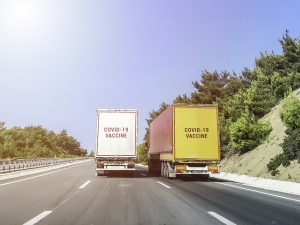
The COVID-19 vaccines have arrived — and so have the questions, the chaos, and the many, many, many news articles.
Attempting to navigate the pressures of a pandemic that has infected nearly 100 million worldwide — as of January 25 — is no easy feat for those working in trucking and transportation. Luckily, the arrival of the vaccines in the U.S. — and different parts of the world — signify light at the end of this immensely long tunnel.
Read on to learn what COVID-19 vaccines forecast for our industry and the country’s supply chain.
An emergence of elusive optimism
Bob Costello, the chief economist at the American Trucking Associations, anticipates a substantial economic presence for freight in 2021. He emphasizes that belief is dependent on the vaccine and how quickly it reaches the general population. If vaccine distribution meets expectations, it can likely result in a return to normal for sectors seeing less business, like manufacturing, which would also result in expanded freight demand.
Additionally, last-mile businesses can expect to see more growth if they support the medical sector and vaccine deliveries. While larger carriers, like FedEx and UPS, are the big names mentioned in global vaccine distribution efforts, smaller businesses will continue playing significant roles in securing the deliveries to the public.
States and the supply chain
It's no secret that U.S. vaccine distribution efforts have been met with a fair share of hurdles.
On January 25, the Centers for Disease Control and Prevention (CDC) released data highlighting the staggering difference between the number of vaccines distributed versus the number administered. Over 41 million doses have been sent out, while less than 23 million have been given.
One of the primary reasons for the stark contrast, according to BBC News, can be attributed to disparities between federal funding and local and state resources. The U.S. health system, for example, has services run by various providers in each state. These providers either report to government bodies or operate independently, which quickly results in coordination challenges if distribution efforts are not sufficiently mapped out.
Alaska, West Virginia, North Dakota, South Dakota, and New Mexico were the five states with the highest number of administered vaccine doses per 100 people. In contrast, Wisconsin, South Carolina, Georgia, Nevada, and Alabama were the five states with the lowest number. Local representatives working with the supply chain have been calling for additional support on the federal level. With that support, these officials say they can set up additional vaccine centers with trained staff.
Expansion continues for eligible vaccine candidates
Earlier this month, the CDC expanded its list of recommendations for COVID-19 vaccine administration. Here are their suggestions to date:
- Phase 1a: Healthcare workers and residents of long-term care facilities
- Phase 1b: Frontline essential workers, such as grocery store clerks and public transit employees, along with people aged 75 and up
- Phase 1c: People aged 65 and up, people aged 16-64 with underlying medical conditions, and other essential workers, including those working in transportation and logistics
As the criteria for those eligible for the vaccine continues to widen, our industry must continue preparing for increased demand while balancing vaccination schedules for essential workers. Since transportation and logistics professionals are now included in the first phase of vaccinations, fleet businesses that rely on truckers must ensure that drivers receiving their shots are able to receive them in a timely manner and in coordination with their work and travel schedules.
The new administration's new approach to vaccine distribution
On his second day in office, President Biden signed executive orders aimed at increasing COVID-19 vaccinations. To ensure better supply and circulation efforts, the Biden administration is planning to increase the number of vaccination sites by creating federally-led community vaccination centers in local communities. With these efforts in place, the president has established a goal of administering 100 million vaccine shots in 100 days.
Over two weeks ago, President Biden's team also announced they would be parting with the former administration’s policy of holding back half the country's vaccines. The president's administration has stated this acceleration of vaccine distribution will ensure more Americans are vaccinated faster. The former policy was put in place to ensure second doses remained available, as both the Pfizer/BioNTech and Moderna vaccines require two doses administered at different time intervals. Releasing all vaccines to the public as soon as they are ready will impact supply and demand — although what that impact will be will depend on execution.
Administering the specified doses at specified times is crucial, according to the U.S. Food and Drug Administration (FDA), as the vaccines' effectiveness depends on the symbiotic relationship between the doses. Biden's team believes that vaccine manufacturers can produce second doses promptly and remain aligned with first-dose shots. One of Biden's proposed plans, should vaccine supply begin to fall short, is to use the Defense Production Act, which would assist the supply chain with ramping up logistics and distribution efforts. You can learn more about the Biden-Harris COVID-19 plan here.
More vaccines are — most likely — near
Several frontrunners are nearing the end of their vaccine trials, and freight industry leaders may be far more equipped to deliver these doses.
Johnson & Johnson is expected to release data from their late-stage clinical trials to the FDA in several weeks. If successful, this vaccine would be the first one to be given in a single dose. Additionally, it can be stored at standard refrigerated temperatures. In contrast, the Pfizer vaccine must be kept at -100 degrees Fahrenheit. For trucking and transportation vaccine distributors, these criteria would be a welcome improvement from the previous vaccines' high-maintenance and technically challenging needs.
One thing is certain, though. While we are still in the early chapters of the COVID-19 vaccine story, freight professionals will continue playing a leading role in ensuring triumph.
Stay in the know on all the latest COVID-19 vaccine updates with the CDC's COVID-19 vaccine page. You can also read our thoughts on the importance of supply-chain synchronization in this November blog post
